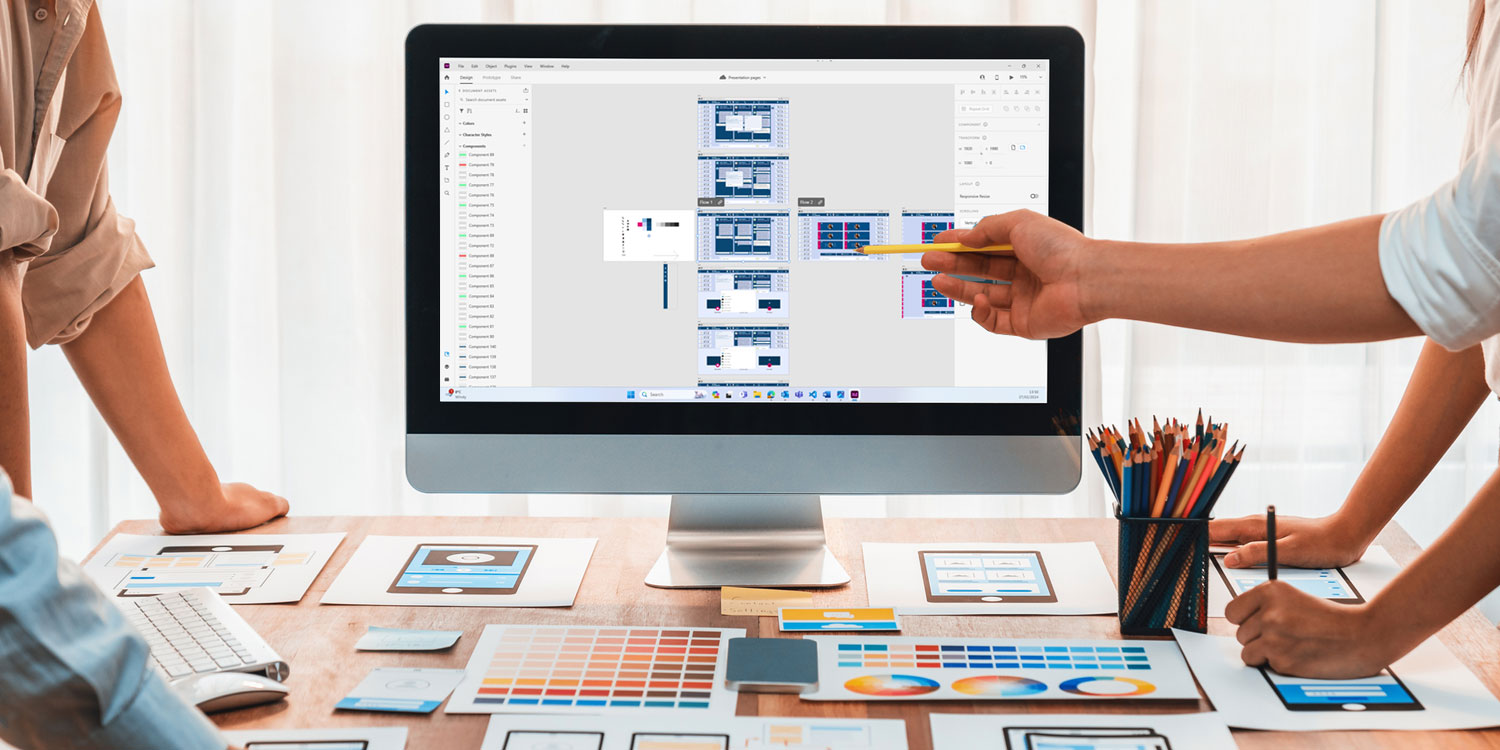
Fast and efficient access to your trading tools is paramount in voice trading. The tools and devices are becoming increasingly complex, while simple, intuitive interfaces are becoming increasingly critical in complex trading workflows.
This article explores the advantages and positive impacts of consistent User eXperience (UX) and our design methodology at Speakerbus.
The benefits you get from great UX
The UX in trader voice solutions, used by financial professionals, mainly brokers or traders, to facilitate real-time communication and execute complex transactions is of paramount importance.
Here’s our top considerations for great UX and more efficient workflow:
Efficiency and Speed: Traders rely on fast and efficient communication to execute trades swiftly. A well-designed user experience ensures that traders can quickly access the necessary tools and information, enabling them to make split-second decisions confidently.
Accuracy and Reliability: In trading, accuracy and reliability are critical. A trader voice system with a streamlined UX reduces the likelihood of errors and ensures that traders can consistently rely on the system to deliver accurate information.
Customisation and Personalisation: Traders have diverse needs and preferences. A trader voice system with customisable interfaces and personalised settings allows traders to tailor the platform to their specific requirements, enhancing their overall experience and productivity.
Intuitiveness and Ease of Use: The trading environment is fast-paced and complex. An intuitive user experience minimises the learning curve for new traders and allows experienced traders to navigate the system seamlessly, maximising their efficiency and reducing the risk of errors.
Integration with Other Tools: Traders often use various tools and systems to support trading activities. A trader voice system with seamless integration capabilities enhances workflow efficiency by allowing traders to access relevant information and tools from within the same interface.
Compliance and Security: Compliance with regulatory requirements and data security are paramount in the financial industry. A well-designed trader voice system incorporates robust compliance features and security measures to ensure that sensitive information is protected and regulatory obligations are met without impeding the user experience.
Adaptability to Changing Market Conditions: The financial markets are dynamic and constantly evolving. A trader voice system with agile UX design can adapt to changing market conditions and technological advancements, ensuring that traders have access to the latest tools and features to stay competitive.
Collaboration and Communication: Effective communication and collaboration among traders are essential for success in the financial markets. A trader voice system that facilitates seamless communication and collaboration enhances teamwork and decision-making, leading to better outcomes for traders and their organisations.
What design techniques do Speakerbus use to achieve these benefits?
I recently sat down with Rosy Wodhams, Speakerbus' UX designer, to gain her insights into our Graphical User Interface (GUI) design and development methods used at Speakerbus.
User-Centred Design (UCD)
Rosy affirmed the critical importance of User-Centered Design (UCD) in shaping our GUIs. For instance, she noted that traders typically rely on just a handful of primary buttons, such as volume controls and microphone toggles, during their calls. Consequently, design decisions revolve around ensuring easy access to these essential buttons, prioritising their visibility and accessibility.
"Our goal, ultimately, is we want our user's experience to be as efficient as possible to enhance their everyday trading experiences." Said Rosy Wodhams, UX Designer at Speakerbus. She continued, "Understanding the most critical features required on the screen/turret has enabled us to remove other elements that are not important and are very rarely used."
Rosy further emphasised the importance of comprehending user needs, which we glean through behavioural analysis, observing natural hand movements on the screen and identifying seldom-used buttons or features.
Moreover, Rosy underscored how UCD streamlines the design process by enabling the removal of clutter. Excessive on-screen clusters can impede efficiency and frustrate users. Therefore, we aim to minimise buttons and simplify the user interface to enhance efficiency and satisfaction.
Design Thinking
Design Thinking is another integral approach employed at Speakerbus, encompassing a collection of cognitive, strategic, and practical methodologies our designers use during the design process. It also includes the accumulated knowledge about how individuals’ reason when confronted with design challenges.
As explained by Rosy, this methodology is consistently applied throughout our development processes. "Given the array of trading solutions we offer, regular prototyping is crucial," she emphasised.
Rosy elaborated that each prototype initiates with an initial ideation phase, where designers engage in creative sessions to generate ideas (commonly known as brainstorming). As concepts evolve, prototyping becomes instrumental in forging innovative solutions.
Subsequently, collaborative efforts ensue. "Presenting the prototype to individuals and observing their interactions can be immensely beneficial," Rosy noted. She explained, "As people have diverse interpretations and interactions, this process aids in redefining problems."
Consequently, the design team's problem-solving process becomes more nuanced, facilitating a deeper focus on details and ultimately fostering solutions to intricate problems.
Rosy further explained that the team shares UX prototypes through Adobe XD links, granting individuals access to the entire graphical user interface for interpretation. "The link enables users to click and navigate through various pages. Observing users' clicks proves highly advantageous," she remarked.
"Often, users raise questions about certain features or functionalities, such as why a particular click leads to a specific action or why a popup message appears," Rosy continued, "This feedback informs the creation of alternative solutions, which are frequently preferred and implemented."
For instance, Rosy provided a straightforward example: When hovering over a blue microphone button, it changes to red to indicate that clicking it will turn off the microphone. Some users suggested a visual representation of a crossed-out microphone to signify the same action, which was subsequently integrated into the design based on user preference.
Agile UX - Successful design is simple.
The next design method to discuss is Agile UX. Agile UX is a design and development approach that combines the principles of Agile software development with design principles. Incorporating Agile UX into the process of product creation leads to both highly functional and simple-to-use products that users will love to engage with.
Overcomplicated designs can cause problems for many users. Agile UX helps us identify simple-to-use products.
"Ultimately, we want our product to be as best suited to our customers as possible." Said Rosy.
To achieve this, Speakerbus constantly engages our clients for design feedback. Constant user feedback drives our development process, allowing us to obtain more significant insights into product requirements.
We improve our product based on user feedback and the regular evolving needs.
Responsive Design
Rosy underscored the significance of responsive design, the final method she highlighted. This design approach focuses on ensuring optimal rendering of web pages and applications across various devices and screen sizes, ensuring usability and satisfaction regardless of the viewing environment.
"Our web-based products are engineered to cater to every user," Rosy emphasised.
Consequently, our solutions dynamically adapt to diverse screen sizes, including tablets and mobile devices, enabling seamless access from anywhere.
During design presentations to clients, we offer various design variations, allowing them to select preferred graphics, including icon colours, background schemes, and layout preferences.
"Our forthcoming applications leverage modern technology stacks like React, ensuring compatibility across desktops, mobile devices, and beyond," Rosy elaborated.
Additionally, Speakerbus provides customisation options through our API, encompassing theme colour adjustments and logo integration.
Furthermore, we extend complete customisation capabilities to individuals, tailoring designs to their preferences. This includes scalable images and customisable colour schemes such as light or dark backgrounds. Rosy stressed, "Our customers' needs are paramount in our design process, driving us to prioritise responsiveness in all our designs."
Closing Thoughts
In conclusion, the consistent user experience (UX) offered by Speakerbus plays a pivotal role in the fast-paced world of voice trading. With trading tools becoming increasingly complex, the importance of intuitive interfaces cannot be overstated.
Our meticulous approach to UX design, incorporating methodologies such as User-Centered Design (UCD), Design Thinking, Agile UX, and Responsive Design, ensures that our products are not only efficient and reliable but also customisable to individual preferences.
By putting our clients at the centre of our design decisions and constantly iterating based on their feedback, we strive to deliver solutions that enhance efficiency, productivity, and user satisfaction in the ever-evolving voice trading landscape.
Stay tuned for deeper dives into more engaging topics as you continue your journey in the exciting realm of trader voice technology.



